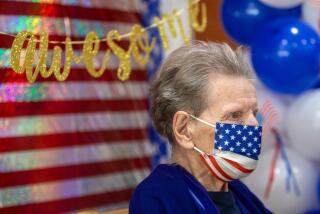Fiery Crash Gave Teacher a Mission of Helping Burn Victims in School, Career
- Share via
When Barbara Kammerer was 33, her life radically changed.
In a freak collision in Huntington Beach, her date’s sports car was rear-ended by a larger car, causing it to explode into flames and leaving her to suffer second- and third-degree burns over most of her body. Her face was severely disfigured, her left hand deformed and the fingers of her right hand had to be amputated. Her date survived with minor injuries.
A year and a half later, she returned to her teaching position at Orangeview Junior High School in Anaheim, only to realize that her skills as a teacher could be put to even better use. She left her academic post and devoted herself full-time to helping burn victims re-establish their lives.
Today the Huntington Beach resident will be inducted into the Governor’s Hall of Fame for People with Disabilities, an honor she will share with six other Californians, among them deaf actress Marlee Matlin, who won an Academy Award in 1986 for her role in the film “Children of a Lesser God,” and Mark Wellman, who gained fame last summer as the first paraplegic to scale El Capitan.
“I feel very honored by the recognition,” Kammerer said Thursday. “I have a tremendous amount of support from my colleagues, family and friends who encourage me to do the work I do.”
Kammerer created the Total Image Center--a program for recovering burn victims that is now a national model. From her office at Rancho Los Amigos Medical Center in Downey, she also operates an educational program designed for student victims who are re-entering the school environment.
At the Total Image Center, Kammerer teaches burn victims unorthodox ways to adjust to their disability by using fashion and cosmetics--and experts say she has revolutionized the recovery of burn victims across the country.
After her accident, she took courses at the Westmar Academy of Cosmetic Art in Sherman Oaks and the Fashion Institute of Design and Merchandising in Costa Mesa, and learned ways to match certain colors of cosmetics and clothing styles to help those with disfigurations “look their healthiest.”
“People in the business world and other professions spend a lot of time and energy and (put) money into developing their personal image. People with disfigurations and disabilities need to have the same tools dedicated to them because they are developing a whole new image,” she said. “They are learning to do the most with what they have and be the best they can be. . . .
“It’s very frustrating for me to realize that there are tools available to assist people in their rehabilitation and there are many hospitals out there in the world that are not giving these tools,” said Kammerer, who sees “hundreds” of burn victims and their families each year between managing her programs in California and visits to burn centers throughout the country.
She also teaches ways to boost self-esteem through physical communicators such as speech and posture, with the aim of rebuilding the confidence of those whose lives are often completely altered by their disability.
“Healing isn’t just physical,” she said, “it’s spiritual, mental and psychological. All of that needs to be addressed if we’re really treating the whole person.”
Through the school re-entry program, Kammerer uses her knowledge of children and classrooms to lead an educational program at schools where burn victims will be returning.
The No. 1 thing she tells students and faculty at the schools is that it’s all right to look at the returnee’s disfiguration, but even better, she said, “make eye contact and say ‘hello.’
“Usually children are immediately told, ‘Don’t stare,’ and so the message everyone’s had since childhood is that we feel uncomfortable, we don’t interact with somebody who is different,” she said. “The kids need to know that they’re capable and competent to handle the situation.”
Kammerer was chosen as a Governor’s Hall of Fame candidate by the state Department of Rehabilitation. The Hall of Fame, established last year with the first six inductees, seeks to recognize the achievements of those with disabilities as a tool toward better integrating the handicapped into society, said Judy Tafoya, assistant director for special projects at the agency.
“We’d like to use their (people such as Kammerer) expertise and experience in promoting public understanding and acceptance of people with disabilities of all walks of life,” Tafoya said.
Kammerer says a friend once told her that a crisis can sometimes bring change that, in the long run, is for the better. She agrees. “Now,” she said, “the best part is knowing that I’ve maybe played a small part in somebody’s ability to win in life again.”
More to Read
Sign up for Essential California
The most important California stories and recommendations in your inbox every morning.
You may occasionally receive promotional content from the Los Angeles Times.










